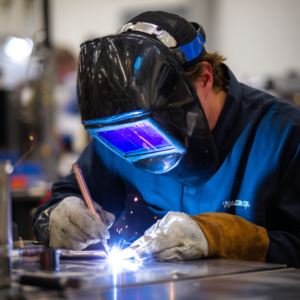
Why Welding Certification Classes Matter for Your Career
In many fields, including oil and gas, power generation, and heavy fabrication, the demand for certified welders is on the rise. Each year, new projects push the limits of metalwork and specialized construction, and that opens the door for you to build a rewarding career in this skill-based trade. If you have ever considered welding certification classes, you may already know that credible training can help you stand out, raise your earning potential, and reduce the risk of on-the-job mistakes. Below, we will explore these welding certification classes in depth, highlight which programs might be right for you, and show you why serious employers often invest in certified training for their teams.
Understanding welding certification classes
Welding certification classes provide structured instruction and hands-on practice to help you master specific welding processes. These welding certification classes often follow industry-approved standards, such as those set by the American Society of Mechanical Engineers (ASME) or the American Welding Society (AWS). By completing accredited programs, you confirm that you can safely perform the required welds, meet quality benchmarks, and follow proper safety procedures. Beyond the classroom, you will train on real metal joints, perfect your technique, and prove that you can deliver consistent results in different environments. Enrolling in welding certification classes also shows employers that you are serious about developing your craft and meeting industry standards.
A variety of industries rely on certified welders. Think of oil and gas refineries, commercial building developments, and modular construction sites that need dependable pipe joints and sealed vessels. Employers in these areas frequently search for welders who can handle advanced methods, such as Tig welding (Tungsten Inert Gas) or GMAW (Gas Metal Arc Welding). Certification ensures that these methods meet strict engineering and safety guidelines. For example, Red River is an ASME certified pressure vessel manufacturer, meaning they must adhere to detailed construction codes. Welding certification classes are especially valuable in that ecosystem,, where any mistake could cause both financial and safety concerns. If you are curious about specialized programs, you can even look into gtaw welding certification to gain further precision skills for projects demanding top-quality welds.
Many newcomers worry that they need a long list of prerequisites or advanced math skills to sign up for classes. However, some training providers, including Red River’s Capabilities, say you can start with basic aptitude and a willingness to learn. They will guide you on AWS or ASME standards, material properties, and best practices. By enrolling in recognized welding certification classes, you earn the building blocks for a solid career path, whether that is creating structural beams, pressure vessels, or custom modular skids. On top of that, having a clear formal certification often boosts your résumé, showing your dedication and readiness to work safely.
Five essential welding certification classes
Below, you will find five key welding certification classes worth considering. Each serves a different niche, but all reinforce fundamental safety protocols, core welding theory, and practical skills. Taken together, these welding certification classes can help you build a strong foundation, while also preparing you to become a versatile professional who can tackle a range of projects.
Gas Tungsten Arc Welding (GTAW) or TIG
Gas Tungsten Arc Welding, often called TIG welding, relies on a tungsten electrode and inert gas shielding. GTAW is highly respected for its accuracy and clean finishes. Many industries use it for thin metals, stainless steel, and critical pipes. If you are considering TIG welding certification classes, you might work on high-pressure lines, food-grade equipment, or aerospace components.
- Skill focus: Precise control over heat input, steady hand positioning, and knowledge of gas flows
- Ideal for: Thin metals, stainless steel, or aluminum
- Typical industries: Aerospace, power generation, advanced piping
Red River, for example, emphasizes GTAW in many of their pressure vessel fabrication projects. They train their workforce to handle carbon steel, stainless steel, and specialized alloys under strict ASME guidelines, often through structured welding certification classes. (Red River).
Flux-Cored Arc Welding (FCAW)
Flux-Cored Arc Welding uses a wire electrode with a flux core, producing a slag cover that protects the weld. FCAW is known for speed and deeper penetration, especially for heavy fabrication settings. As part of many welding certification classes, it is a top choice when you need strong welds, even in outdoor or windy conditions. These welding certification classes often highlight FCAW because of its reliability in structural projects and field applications where consistency is critical.
- Skill focus: Managing slag removal, controlling spatter, working with high deposition rates
- Ideal for: Large structural projects or thick sections
- Typical industries: Shipbuilding, construction, modular factories
Shielded Metal Arc Welding (Stick)
Shielded Metal Arc Welding is one of the more traditional methods, but it remains fundamental in various sectors. Often taught first in many welding certification classes, it helps you learn electrode handling and puddle control under many conditions. These welding certification classes also stress the importance of adaptability, since stick welding can be applied in construction, repair, and maintenance across different environments.
- Skill focus: Proper electrode angle, consistent arc length, avoiding erratic arcs
- Ideal for: Maintenance in remote locations, quick repairs, general construction
- Typical industries: Rural construction sites, repair services
Gas Metal Arc Welding (GMAW) or MIG
Gas Metal Arc Welding, or MIG, uses a continuously fed wire and shielding gas, making it simpler to learn than some other processes. Frequently included in welding certification classes, it finds frequent use in automotive work, certain manufacturing lines, and anywhere large, continuous welds are preferred. These welding certification classes often introduce MIG as a starting point because of its efficiency and ease of learning, making it ideal for newcomers who want fast, practical results.
- Skill focus: Steady wire feed, controlling voltage and wire speed, preventing burn-through
- Ideal for: Mild steel, aluminum, sheet metals
- Typical industries: Automotive, light fabrication, furniture
Pipe Welding (Advanced Levels)
Pipe welding classes push your skills to the limit. These focused welding certification classes emphasize multi-position welding (horizontal, vertical, overhead) to join pipes used in high-pressure systems. You will typically see coding tests that validate your ability to create X-ray quality welds. Many advanced welding certification classes also simulate real job-site conditions so you can prepare for the challenges of working on pipelines, refineries, and other critical infrastructure.
- Skill focus: Welding in tight spaces, mastering root passes, controlling distortion
- Ideal for: Pressure vessels, oil and gas lines, petrochemical facilities
- Typical industries: Refineries, power plants, pipeline construction
Below is a brief comparison table for quick reference:
| Class | Key Materials | Skill Complexity | Main Uses |
| GTAW (TIG) | Thin metals, alloys | High | Precision work, pipe lines |
| FCAW (Flux-Cored) | Thicker metals | Moderate | Heavy fabrication |
| SMAW (Stick) | Steels | Moderate | Repairs, varied conditions |
| GMAW (MIG) | Mild steel, aluminum | Beginner-friendly | Automotive, light fab |
| Pipe Welding (Advanced) | High-tensile steels | High | Pressure systems, refineries |
Depending on your goals, you might begin with MIG or Stick and expand to GTAW or pipe work for higher-paying opportunities. There is no one-size-fits-all route. If you plan to tailor your learning around GTAW, you can also explore how to get your TIG welding certification test or see how to pass tig welding certification test for detailed tips.
Selecting your ideal training provider
Choosing the right welding certification classes depends on your career goals, budget, and the skill level you hope to achieve. Here are five points to consider:
Accreditation and industry alignment
Look for a provider accredited by recognized organizations (ASME, AWS, or local equivalents). These are signs that the curriculum and testing environment meet rigorous standards. For instance, Red River is an ASME-certified manufacturer that also trains its team to handle pressure vessels, prefabricated modules, and specialized skid packages. By learning under providers who follow these industry norms through structured welding certification classes, you ensure your new certification will hold weight.
Safety culture and hands-on practice
A reliable program will not just talk about safety, but embed it into each step of your training. Providers with a history of safe operations, like Red River, typically have in-depth safety protocols and encourage open communication. You will want an instructor who offers real-time feedback, fosters skill mastery, and introduces more challenging weld positions as you progress. Some welding certification classes may give you sample plates and pipes to practice for hours a day. Others emphasize quick theory modules. If you are aiming for serious mastery, check how many actual weld hours you will receive.
Range of welding processes offered
If you want to specialize in pipe welding, you should find a training center with advanced machine setups, overhead welding capabilities, and instructors experienced in out-of-position welding. If you are unsure which process suits you best, pick a broad program that covers MIG, TIG, Stick, and FCAW. Many of these programs are structured as welding certification classes, and over time, you can then branch out into advanced courses.
Workforce experience and instructor credentials
Ask if the instructor has practical, real-world expertise. Certifications and formal training are helpful, but years spent on pipelines or in pressure vessel shops can provide more thorough insights. Programs that hire seasoned pros bring you up close with common welding challenges, best ways to fix mistakes, and top-tier safety practices that might not appear in a textbook. These advantages make welding certification classes especially valuable.
Post-completion opportunities
Some schools or organizations help with job placements. Others partner with manufacturing facilities or local contractors to give graduates a clear next step. If your main aim is immediate employment, look for a program that is recognized by local employers. Many of these opportunities are tied to welding certification classes. If you want to expand your skill set further, see if they offer advanced tracks, such as pipe inspection or specialized fabrication for modular skids.
Why welding certification classes matter
It is easy to see how welding certification classes can fuel your career, whether you are new or just brushing up on advanced techniques. You gain tangible proof of your abilities, become far more marketable, and learn in an environment emphasizing safety alongside skill development. In an industry that demands consistent quality, it helps to have recognized qualifications that say your welds can stand up to real-world stress. Providers like Red River underscore the importance of well-trained teams who can build pressure vessels, prefabricated units, and modular skids at a high caliber.
Some schools or organizations help with job placements. Others partner with manufacturing facilities or local contractors to give graduates a clear next step. If your main aim is immediate employment, look for a program that is recognized by local employers. Many of these opportunities are tied to welding certification classes, which give you credentials that employers trust. If you want to expand your skill set further, see if they offer advanced tracks, such as pipe inspection or specialized fabrication for modular skids.
If you are not certain where to start, you can research more about where to take welding certification classes or explore how to get welding certification classes. By making a thoughtful choice, you will build a strong skill foundation and set the stage for a lasting career.
Take the Next Step with Welding Certification Classes
If you are ready to start, research where to take welding certification classes or explore how to get certified today. The sooner you begin, the faster you can access new opportunities and higher-paying welding roles.
Frequently Asked Questions
1. Where to take welding certification classes
You can take welding certification classes through accredited providers that follow standards like AWS or ASME. Many programs are offered by training centers, technical schools, or manufacturers such as Red River, which train welders on pressure vessels and modular fabrication under strict codes.
2. How to get welding certification classes
To get started, choose a recognized provider, enroll in classes that fit your goals, and complete hands-on training with safety and testing standards. Many programs don’t require advanced prerequisites, just aptitude, willingness to learn, and commitment to practice.
3. What are the best welding certification classes
The best welding certification classes depend on your career path. MIG and Stick are beginner-friendly, while TIG, Flux-Cored, and advanced pipe welding provide higher-level skills. If you aim for high-paying opportunities, advanced programs like GTAW or pipe welding certification are highly valuable.
4. Can I focus on just one welding method, like TIG?
Yes. If you want deeper expertise in Gas Tungsten Arc Welding, choose courses labeled specifically as GTAW or TIG. You can also explore what is tig welding certification to see if this specialty aligns with your goals.
5. Are there online welding certification options?
Some providers offer hybrid or partial online programs for theory-based content. For practical elements, you must still practice in person. If you are curious, check out welding certification online to see if you can blend remote tutorials with lab work.
Key takeaways
- Formal training raises your credibility and safety awareness, making you more attractive to a broad range of employers.
- Different welding processes (GTAW, MIG, Stick, FCAW, pipe welding) serve distinct industries and skill levels. You can mix and match certifications based on your interests.
- Top training providers (including those with ASME or AWS accreditation) provide structured classes with hands-on, real-world practice.
- Seek programs that emphasize safety culture, strong instructor credentials, and advanced technique development.
- Certified welders often command higher salaries, enjoy more stable employment, and unlock specialized welding roles in fields like prefabrication, pressure vessels, modular skids, and more.
Related Blog Post

Where to Get Welding Certification Online for Your Career

How to Get Welding Certification Online Without Breaking a Sweat

Can You Get Welding Certification Online? Here’s the Truth

Why You Should Consider Welding Certification Online

